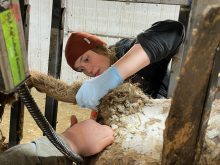CALGARY – Some women claim it only takes a wink and a smile for them to get pregnant.
Infertile couples wish it was that easy.
Calvin Greene, director of the regional fertility program at Foothills Hospital in Calgary, says the clinic evaluates 1,400 couples a year referred to them by family doctors and specialists.
Infertility is defined as one year of unprotected intercourse without achieving pregnancy. It affects 10 to 15 percent of all couples.
As well, it carries with it psychological factors and many people have a misconception that the woman is always at fault when almost a third of the time, the problem lies with the man.
Read Also

Feds propose overhaul of chronic wasting disease control program
Chronic Wasting disease control program getting updated by Canadian Food Inspection Agency with feedback encouraged from producers.
“Infertility is a couple problem,” said Greene.
Many people find the treatments can take their toll, both physically and mentally. According to Greene, it’s important for couples undergoing treatment to keep it in perspective.
“It’s people wanting to have a family,” he said.
One form of treatment is in-vitro fertilization which involves fertilizing an egg with sperm in a laboratory outside the woman’s body. After fertilization, the egg is replaced in the mother’s uterus. This is often done because of tubal damage, male infertility or when other treatments have failed.
One of the newest technologies takes a sperm sample from a prospective father and injects one viable sperm into an egg.
The success rate of this process is about 35 percent the first time with fresh embryos. For successive tries with frozen embryos, success drops to about 15 percent. Overall, half of the clinic’s patients achieve a pregnancy, said Greene.
Because two to five embryos are implanted at one time to improve the odds of a successful pregnancy, there’s a 20 percent chance twins may be born. Triplets are born about five percent of the time, said Greene.















